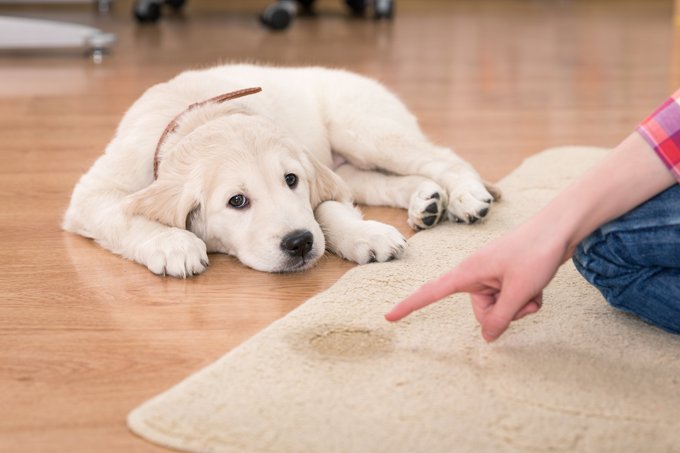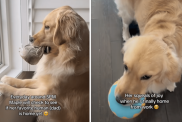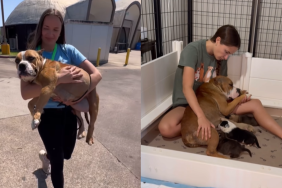To set your new dog or puppy up for a lifetime of good toilet habits, it’s important to start housetraining right away–the very day she comes home. This means you’ll need to get all the housetraining equipment ahead of time, before you bring your new pup home. Then you’ll need to get her comfortable with the setup as soon as she comes through the door.
Before you bring the new dog home
Get a good crate
The ideal crate is lightweight and collapsible, so you can easily move it from room to room, and just large enough for the dog to comfortably lie down and stretch out. Anything bigger than that, and the dog isn’t as likely to “hold it” while she’s in her crate to avoid soiling her sleeping area–which is crucial for housetraining.
Wire crates are nice for pups who don’t like to be alone because they can see what’s going on around them, making them feel less isolated. Solid plastic airline crates work well for puppies who get over-stimulated easily, or those who like to have a cozy den to retreat to. You can ask your dog’s current caretaker which type she’s likelier to feel at home in.
It’s fine to line the crate with some comfy bedding, but after your pup’s first night home, check it for dampness as soon as you get up. If it’s wet, take it out. You can put the bedding back when your dog’s gone a full week with no accidents in the crate.
Make a puppy playroom
When you have to leave your puppy home alone, or if you’re too busy to follow the housetraining program, it’s best to keep your dog in a puppy playroom with an indoor “doggy toilet.” This keeps your puppy from eliminating in other parts of the house–something that can quickly turn into a bad habit.
A good playroom is located in a central area of your home and has easy-to-clean, non-absorbent floors; kitchens or bathrooms work well. You can use a gate or an exercise pen to cordon off a small section of the room.
A playroom includes:
* A comfortable crate or bed
* A bowl of fresh water
* Plenty of hollow chewtoys stuffed with dog food
* A doggy toilet in the corner opposite the bed or crate
To make a doggy toilet, cover a litter box, an old piece of linoleum, or a metal tray (such as a removable crate bottom) with whatever will be your dog’s eventual toilet material. For example, for rural and suburban pups, lay down a roll of turf. For urban puppies, use a few thin concrete tiles. Your puppy will soon develop a strong preference for eliminating on similar surfaces when she’s outside.
The day your dog comes home
Let your dog warm up to her crate
The day your puppy or new dog comes home, do a few exercises with her to show her that the crate’s a pleasant place. That way you can start keeping her in the crate as part of her housetraining program.
If you have a puppy: A puppy can quickly learn to love her “doggy den.” Stuff a couple of hollow chewtoys with kibble and a few treats. Let your pup sniff the chewtoys and then put them inside the crate with your dog outside. Within a few seconds, your puppy will probably be begging you to let her inside.
Some puppies do better if you carry their crate from room to room with you, so they don’t feel isolated. Others get overstimulated easily, and will be more relaxed in a low-traffic part of the house. Try it each way, and you’ll soon figure out what your puppy prefers.
If you have an adult dog: It may take a bit more effort to teach your adult dog to love her crate if she’s never been in one before, but it can be done.
Lure your dog into the crate by tossing a treat inside and telling her, “Go to your crate.” At this point, don’t close the door behind her. Repeat this exercise several times.
Once your dog is happily going into the crate, ask her to lie down for a few seconds before offering the treat. Spend time just sitting by the crate, talking to and petting your dog while she’s inside.
Once your dog’s starting to relax inside the crate, close the door for a few minutes at a time with her inside. Stay in the same room, praising your dog and occasionally offering a treat. Gradually increase the length of time she spends in the crate, and begin straying further and further from the room while she’s inside.
Tie chew bones to the crate so she can enjoy them only when she’s inside, and serve her meals in the crate as well.
Some dogs do better if you move their crate from room to room with you, so they don’t feel isolated. Others get overstimulated easily, and will be more relaxed in a low-traffic part of the house. Try it each way, and you’ll soon figure out what your dog prefers.
Now you’re ready to start the housetraining process.
–by Ian Dunbar









